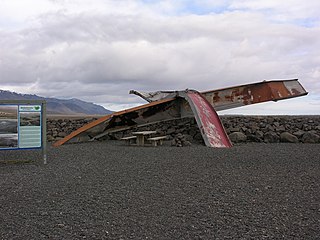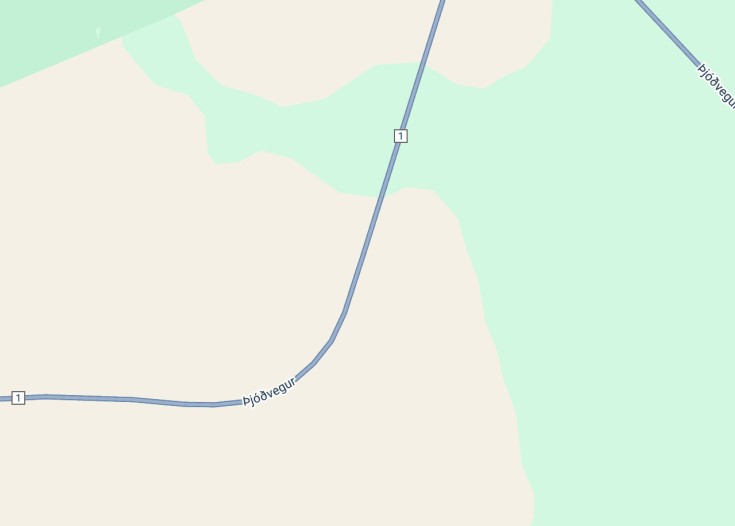The Skeiðará Bridge Monument, located in the vast wilderness of Iceland’s southern territory, stands as a stark reminder of the powerful forces of nature that shape the Icelandic landscape. This monument marks the site of the original Skeiðará Bridge, which was destroyed by a massive glacial outburst flood in 1996. The flood, emanating from the nearby Grímsvötn volcano under Vatnajökull glacier, carried ice blocks weighing thousands of tons, demonstrating the formidable power of Iceland’s natural elements. Today, the remains serve as a historical site, attracting visitors who wish to witness the dramatic interplay between Icelandic infrastructure and the untamable force of nature.
Check the weather forecast and prepare for rapidly changing conditions before visiting the Skeiðará Bridge Monument to ensure a safe and enjoyable experience.
Consider visiting the monument as part of a guided tour to gain deeper insights into the history and geological significance of this unique site.
Skeiðará Bridge Monument: A Testimony to Nature’s Power
The Skeiðará Bridge Monument, located in the serene landscapes of Iceland, serves as a stark reminder of the dynamic and sometimes destructive forces of nature. Originally part of the Ring Road, this bridge was destroyed by a massive glacial outburst flood in 1996. The flood, originating from the Skeiðarárjökull glacier, a part of the larger Vatnajökull ice cap, carried enormous icebergs that wiped out major sections of the bridge.
Today, remnants of the twisted girders stand as a monument not only to the event itself but also to the power of Iceland’s natural elements. For tourists, this site offers a poignant glimpse into the challenges of constructing infrastructure in a country prone to volcanic and geothermal activities. The monument is not only a tourist attraction but also a point of reflection on the resilience and adaptation of human endeavors in the face of nature’s unpredictability.
Exploring the Skeiðará Bridge Monument
The Skeiðará Bridge Monument offers visitors a unique opportunity to witness the impacts of Iceland’s extreme natural events. Near the site, informational plaques detail the history of the 1996 flood, providing insight into the scale of the disaster and its lasting effects on the region’s geography and infrastructure.
For photography enthusiasts and nature lovers, the contrasting visuals of mangled metal against the vast, open landscapes offer a captivating subject. The area is also a starting point for various hiking trails that delve deeper into the surrounding terrain, giving a firsthand experience of Iceland’s rugged beauty and the resilience of its landscapes.
A closer look at the remains
One of the most impactful visuals at the Skeiðará Bridge Monument is the sight of the large twisted metal beams that once formed part of the bridge. These beams, contorted into surreal formations, stand as a powerful symbol of nature’s might.
The site provides an exceptional backdrop for contemplating the forces at play during the flood and the dramatic changes it brought to the landscape. This graphic testament to the strength of nature’s elements makes the monument a significant stop for anyone interested in Iceland’s geological phenomena or the history of its infrastructure.
Discover the Skeiðará Bridge Monument
The Skeiðará Bridge Monument is a captivating destination that appeals to history enthusiasts, architectural buffs, and those interested in the power of nature. This site offers an intriguing glimpse into the challenges of building infrastructure in volatile environments and is suitable for visitors of all ages, including kids, couples, and older people.
Upon visiting, one can expect a deep dive into Icelandic history intertwined with impressive natural landscapes. The monument stands as a testament to resilience against natural disasters, specifically the volcanic eruptions that have shaped the region. It is not just a historical site but also a powerful reminder of the dynamic relationship between human endeavors and nature.
Best Time to Visit the Skeiðará Bridge Monument
The ideal time to visit the Skeiðará Bridge Monument is during the summer months, from June to August. During this period, the weather is more favorable, providing clearer views and easier access to the monument.
Annual Events
If you are planning your visit, consider aligning it with the local Cultural Heritage Festival in July. This event offers additional insights and activities centered around the monument’s history and significance.
Accessibility and Limitations
The Skeiðará Bridge Monument is mostly accessible, though some areas might be challenging for those with mobility issues due to uneven terrain.
Accessibility
Limitations
- Seasonal access: The site may be inaccessible during the winter months due to heavy snow.
- Partial restrictions: Certain areas may be restricted during maintenance or due to weather conditions.
Notes to visitors
- Photography is allowed, but drones require prior permission.
- Please respect the natural surroundings and avoid littering.
General Information
Plan your visit to the Skeiðará Bridge Monument effectively with these details:
Location
Located close to the Vatnajökull National Park, the monument is easily accessible via the main highway that connects with several major towns.
Address:
Skeiðará Bridge Monument, 785 Fagurhólsmýri, Iceland
Opening Hours
The monument is open to visitors throughout the year, though access might be restricted during adverse weather conditions.
Summer: 8:00 AM – 7:00 PM Daily
Winter: 10:00 AM – 4:00 PM Daily
Travel to the Skeiðará Bridge Monument
Traveling to Skeiðará Bridge Monument is convenient and can be done via various modes of transportation:
Car
Most visitors prefer driving as it offers flexibility and the route itself is quite scenic.
| Route | Distance | Travel time |
|---|---|---|
| From Reykjavik | 255 km | 3 hours 15 minutes |
| From Vik | 138 km | 1 hour 50 minutes |
| From Höfn | 193 km | 2 hours 20 minutes |
Bus
Seasonal bus services are available from major towns like Reykjavik and Höfn, with approximate travel times matching those of driving.
Nearby Attractions
Explore these attractions located near the Skeiðará Bridge Monument:
- Skaftafell Ice Cave – 50 km (31 miles)
- Jökulsárlón Glacier Lagoon – 60 km (37 miles)
- Vatnajökull National Park – 40 km (25 miles)
- Ingólfshöfði Nature Reserve – 70 km (43.5 miles)
- Fjallsárlón Iceberg Lagoon – 55 km (34 miles)
- Svartifoss Waterfall – 52 km (32 miles)
- The Crystal Cave – 73 km (45 miles)
- Höfn Maritime Museum – 190 km (118 miles)
- Laki Craters – 104 km (64.5 miles)
- Vik’s Black Sand Beach – 155 km (96 miles)
- Diamond Beach – 65 km (40 miles)
- Seljalandsfoss Waterfall – 200 km (124 miles)
Common Questions
What historical events led to the creation of the Skeiðará Bridge Monument?
What are the main features of the Skeiðará Bridge Monument?
What lessons does the Skeiðará Bridge Monument teach about natural disasters?
How can tourists access the Skeiðará Bridge Monument?
Are there guided tours available at the Skeiðará Bridge Monument?
What type of photography can be done at Skeiðará Bridge Monument?
What is the best time of year to visit the Skeiðará Bridge Monument?
What are the safety considerations at the Skeiðará Bridge Monument?
Can the Skeiðará Bridge Monument be visited with children?
What nearby attractions can be combined with a visit to the Skeiðará Bridge Monument?
How does the Skeiðará Bridge Monument reflect Iceland’s volcanic activity?
What flora and fauna can be observed in the area around the Skeiðará Bridge Monument?

Is the Skeiðará Bridge Monument in Fagurhólsmýri worth a visit?
Located in Fagurhólsmýri, the Skeiðará Bridge Monument serves as a poignant reminder of the raw power of nature. The monument, originally part of a bridge, was destroyed in a massive glacial flood in 1996, marking one of Iceland’s major catastrophic events in recent history. For tourists with an interest in geological phenomena and Icelandic history, this site offers a unique glimpse into the challenges of inhabiting such a dynamic landscape.
However, the site’s appeal might be somewhat limited for those not particularly fascinated by historical infrastructure or geological events. It’s relatively isolated, and aside from the interpretive signage, there’s little else to engage the average visitor. It’s a brief stop rather than a destination, recommended for those passing by or with specific interest in the area’s dramatic history.










